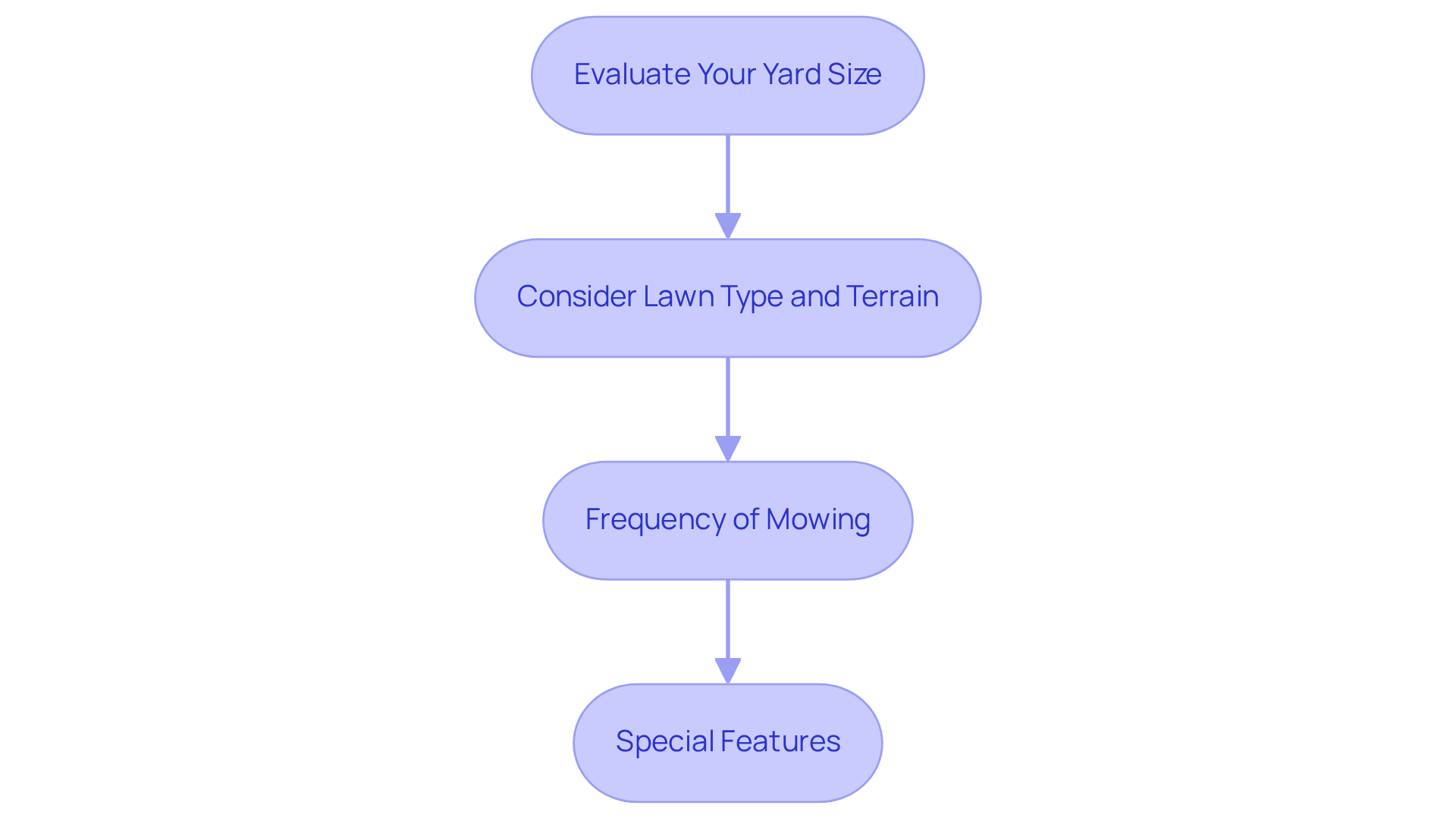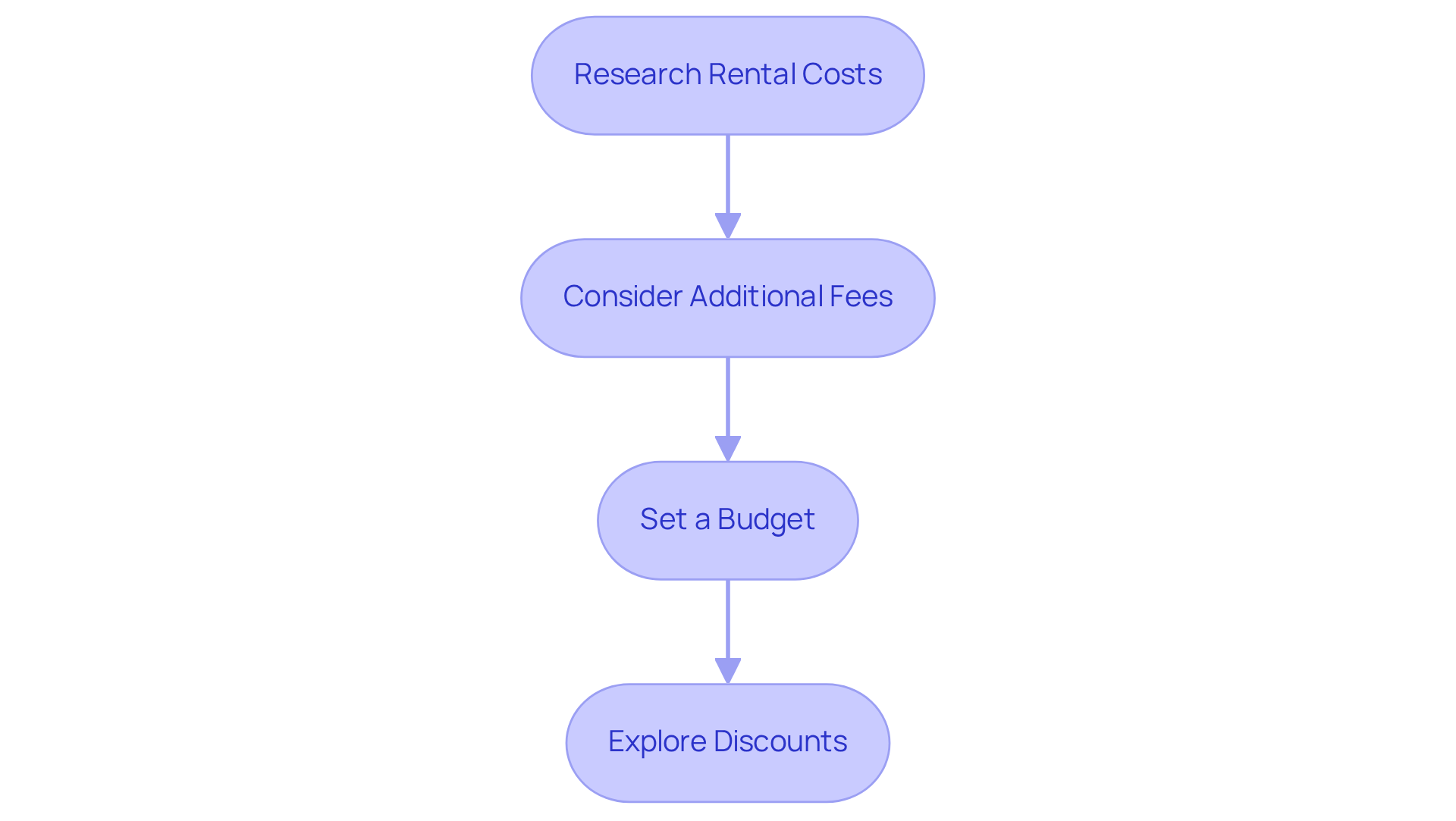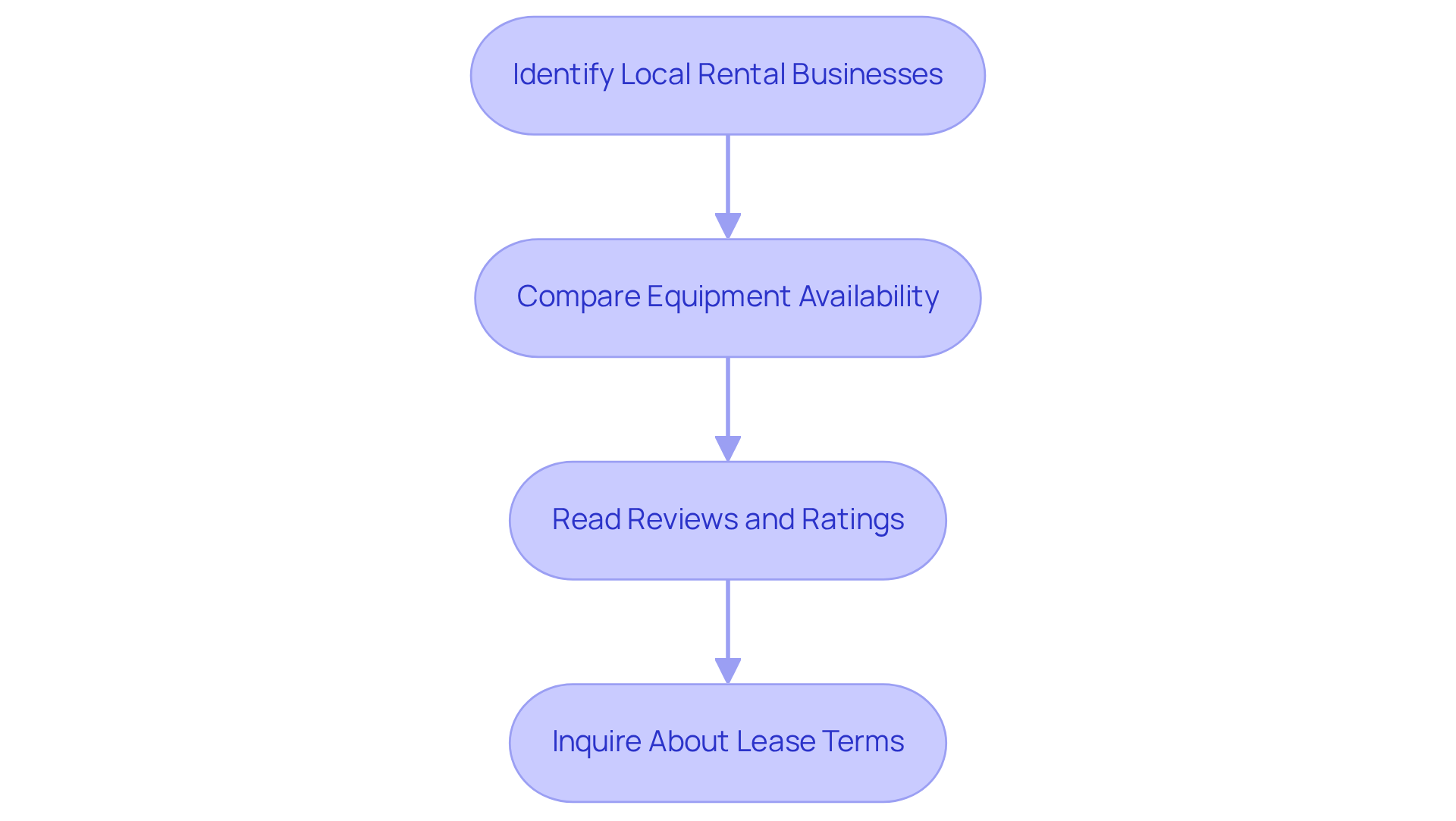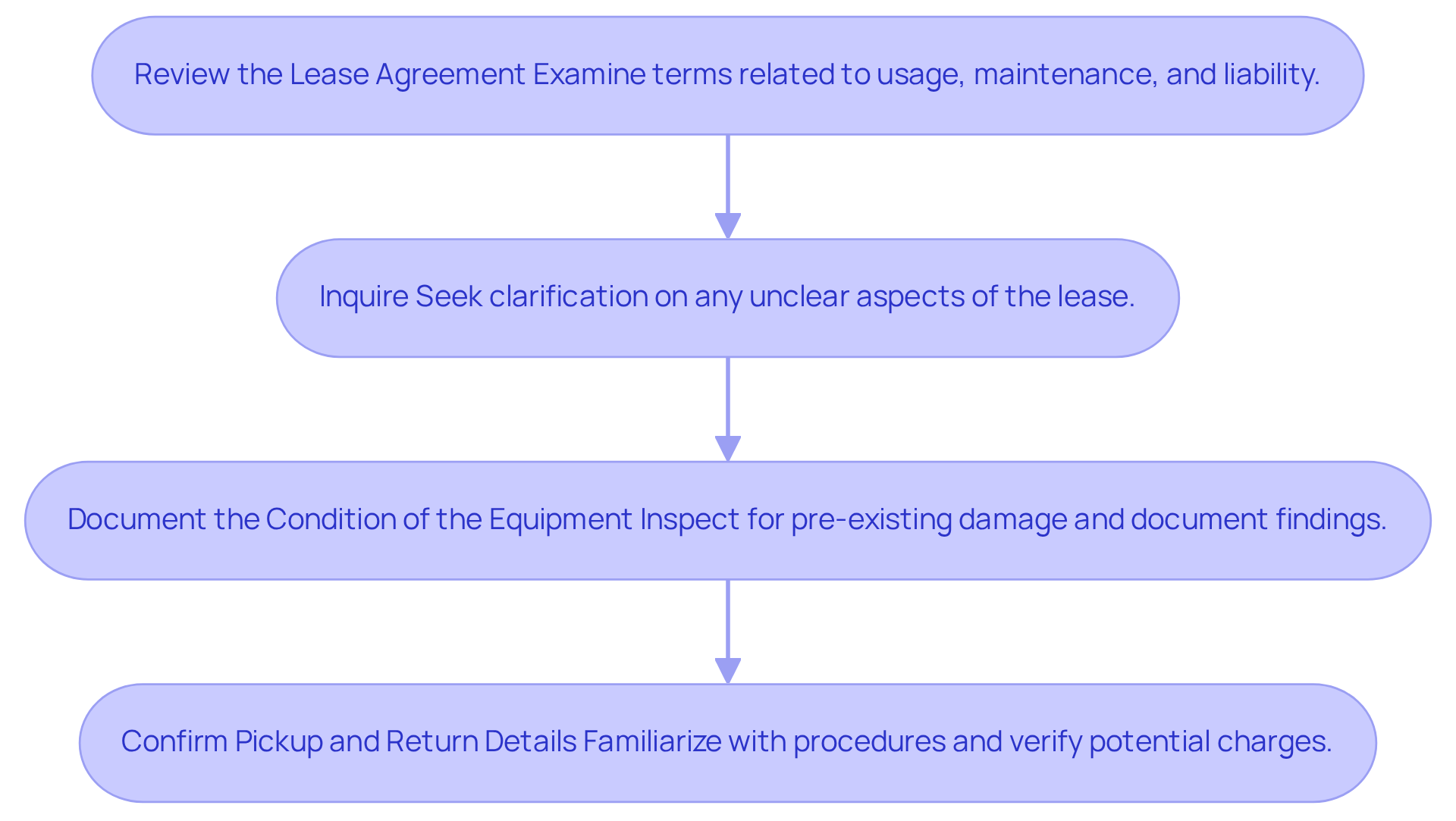Overview
To effectively determine the rental cost of a riding lawn mower, individuals must first assess critical factors such as:
- Yard size
- Terrain
- Mowing frequency
- Specific mower features
In addition, conducting thorough research on rental costs and establishing a budget is essential. This article outlines a systematic approach that includes:
- Evaluating lawn care needs
- Comparing various rental options
- Meticulously reviewing lease agreements
Such practices ensure informed decision-making and promote cost-effectiveness, empowering renters to make the best choice for their lawn care requirements.
Key Highlights:
- Measure yard size to determine the appropriate mower type; push mowers suit small lawns, while larger areas may require riding mowers.
- Consider lawn type and terrain; steep or uneven lawns may need specialised equipment like zero-turn mowers for better manoeuvrability.
- Assess mowing frequency; riding mowers can save time for those with busy schedules.
- Evaluate additional mower features such as bagging capabilities or mulching functions for enhanced lawn care efficiency.
- Research rental costs for riding lawn mowers, which can range from $20 to $100 daily, and consider additional fees like delivery and fuel.
- Set a clear budget for rental costs to avoid overspending and explore discounts for extended rentals or seasonal offers.
- Compile a list of local rental businesses, including options like EZ Equipment Rental, to compare equipment availability and services.
- Read customer reviews to gauge the reliability and quality of rental services, as feedback is crucial for informed decisions.
- Inquire about lease terms, including payment options and any additional fees, for effective comparison between providers.
- Review the lease agreement carefully, focusing on usage terms and maintenance responsibilities before signing.
- Document the condition of the equipment upon receipt to avoid liability for pre-existing damage.
Introduction
Navigating the world of lawn care can be a formidable task, particularly when selecting the appropriate equipment for the job. With an impressive 63,000 square miles of grass across the U.S., it is crucial for homeowners to understand how to effectively manage this extensive resource. This guide presents a comprehensive approach to renting a riding lawn mower, highlighting essential factors such as:
- Yard size
- Rental costs
- The necessity of comparing options
However, what occurs when the ideal mower is financially unattainable, or when the perfect rental option appears elusive? Addressing these challenges can pave the way for smarter decisions and a more streamlined lawn care routine.
Assess Your Lawn Care Requirements
-
Evaluate Your Yard Size: Begin by measuring your yard area to accurately assess its size. For small lawns, typically under 1,000 square feet, a push model is often sufficient. However, for larger areas, it's important to consider how much to rent a riding lawn mower to manage the workload efficiently.
-
Consider Lawn Type and Terrain: Understanding the type of grass and the terrain is crucial. Lawns with steep slopes or uneven surfaces may require specialized cutting equipment, such as zero-turn models, which offer superior maneuverability and control.
-
Frequency of Mowing: Assess how often you intend to mow your grass. If your timetable is busy and you wish to mow less often, you should consider how much to rent a riding lawn mower, as it can significantly decrease the time and effort needed for caring for your yard.
-
Special Features: Think about any additional features that could enhance your mowing experience. Features such as bagging capabilities for grass clippings or mulching functions can enhance yard care efficiency and promote a healthier garden.
In the U.S., grass areas span over 63,000 square miles, making them an important element of landscaping. This vast area emphasizes the significance of effective grass care practices, particularly given that traditionally maintained greens can use as much as 200 gallons of fresh water per individual daily. Comprehending the typical yard dimensions in residential neighborhoods can further guide your rental decisions, especially when determining how much to rent a riding lawn mower to ensure you choose the appropriate tools for your particular requirements. Furthermore, EZ Equipment Rental is dedicated to offering quality and dependable equipment, which is crucial for efficient yard maintenance. By considering the environmental impact of grass maintenance, including the emissions from gasoline-powered machines, you can make informed choices that benefit both your garden and the planet.

Calculate Rental Costs and Budget
-
Begin by researching how much to rent a riding lawn mower and investigating the leasing prices for riding lawn equipment in your area. Costs can vary significantly based on the type of mower, such as how much to rent a riding lawn mower, and the duration of use. For instance, daily rates may range from $20 to $100, making it essential to find out how much to rent a riding lawn mower before proceeding.
-
Consider Additional Fees: It's crucial to recognize potential extra costs, such as delivery fees, fuel charges, and damage waivers. These additional expenses can accumulate quickly, so it’s important to factor them into your overall budget to avoid surprises later.
-
Set a Budget: After conducting your research, establish a clear budget for your lease. Decide on how much to rent a riding lawn mower you are willing to spend and commit to it, ensuring you stay within your financial limits to prevent overspending.
-
Explore Discounts: Finally, investigate whether leasing companies offer discounts for extended rental periods or seasonal promotions. Taking advantage of these opportunities can help you save money while still acquiring the necessary tools for your lawn care needs.

Compare Rental Options and Providers
- Identify Local Rental Businesses: Start by compiling a list of nearby rental firms that provide riding lawn machines, with EZ Equipment Rental being a premier service in the DFW region. With a broad selection of machinery, including boom lifts, forklifts, and mini excavators, EZ Equipment Rental ensures you have access to quality tools for your projects. It is essential to consider both large chains and smaller, local businesses to guarantee a comprehensive selection.
- Compare Equipment Availability: Assess the availability of the specific mower you need at each provider. Some may offer a wider selection or newer models than others, which can significantly impact your project’s efficiency and outcome. Notably, the global equipment leasing market is anticipated to reach $164.6 billion by 2029, underscoring the importance of comparing leasing options.
- Read Reviews and Ratings: Investigate customer feedback and ratings online to evaluate the reliability and quality of service provided by each company. Industry analysts emphasize that reviewing customer feedback is crucial for avoiding potential issues and ensuring a satisfactory experience. Significantly, 30% of American Rental Association members believed that the machinery leasing sector was declining in 2022, highlighting the necessity of assessing leasing firms through client feedback.
- Inquire About Lease Terms: Contact each provider to inquire about their lease terms, including payment options, lease duration, and any additional fees. This information will facilitate a side-by-side comparison. As Josh Nickell, Vice President of the American Rental Association’s equipment segment, states, "You can’t just assume that there’s a piece of equipment on your lot or hope one will be back in time; you have got to do a lot more planning, and use analytics to forecast what your needs are going to be.

Finalize Your Rental Agreement and Terms
-
Review the Lease Agreement: Thoroughly examine the lease agreement prior to signing. Focus on the terms related to usage, maintenance, and liability to ensure a clear understanding of your responsibilities.
-
Inquire: Should any aspect be unclear, do not hesitate to seek clarification from the leasing company. Grasping your obligations is essential for a successful rental experience.
-
Document the Condition of the Equipment: Before accepting the mower, conduct a thorough inspection for any pre-existing damage and document your findings. This step is crucial in safeguarding yourself from being held accountable for issues that existed prior to your rental.
-
Confirm Pickup and Return Details: Be certain that you are familiar with the pickup and return procedures, including specific times and locations. Verify any potential additional charges for late returns or damages to avoid unexpected costs.

Conclusion
Assessing the rental of a riding lawn mower requires a thorough understanding of your specific lawn care needs and the associated costs. By evaluating yard size, terrain, mowing frequency, and special features, individuals can make informed decisions that significantly enhance their lawn maintenance experience. This structured approach not only simplifies the rental process but also guarantees the selection of the right equipment for optimal efficiency.
The article delineates essential steps, including:
- Evaluating lawn care requirements
- Calculating rental costs
- Comparing rental options
- Finalizing rental agreements
Each phase underscores the importance of thorough research and planning, highlighting factors such as local rental businesses, customer reviews, and lease terms. Understanding these elements is crucial for securing the best possible rental experience while effectively managing expenses.
Ultimately, dedicating time to assess lawn care needs and meticulously navigating the rental process can lead to a more manageable and enjoyable lawn maintenance routine. As the demand for effective lawn care continues to rise, being proactive in selecting the right equipment and rental service can significantly impact both the health of your lawn and your overall satisfaction with the results. Engage in this process with diligence and maximize your lawn care endeavors.
Frequently Asked Questions
How should I assess my lawn care requirements?
Start by measuring your yard area to determine its size. For small lawns under 1,000 square feet, a push mower is usually sufficient. For larger areas, consider renting a riding lawn mower to manage the workload efficiently.
Why is it important to consider the type of grass and terrain?
Understanding the type of grass and terrain is crucial because lawns with steep slopes or uneven surfaces may require specialized equipment, such as zero-turn models, which provide better maneuverability and control.
How often should I mow my lawn?
Assess how frequently you intend to mow. If you have a busy schedule and prefer to mow less often, renting a riding lawn mower can significantly reduce the time and effort needed for lawn care.
What special features should I consider for my mowing equipment?
Consider features that enhance your mowing experience, such as bagging capabilities for grass clippings or mulching functions, which can improve yard care efficiency and promote a healthier garden.
What is the significance of grass areas in the U.S.?
Grass areas in the U.S. span over 63,000 square miles, highlighting the importance of effective grass care practices, especially since traditionally maintained lawns can use up to 200 gallons of fresh water per person daily.
How can I make informed decisions about renting lawn care equipment?
Understanding typical yard dimensions in residential neighborhoods can help guide your rental decisions, particularly regarding how much to rent a riding lawn mower to suit your specific needs.
Why should I consider the environmental impact of lawn maintenance?
Considering the environmental impact, including emissions from gasoline-powered machines, allows you to make informed choices that benefit both your garden and the planet.




